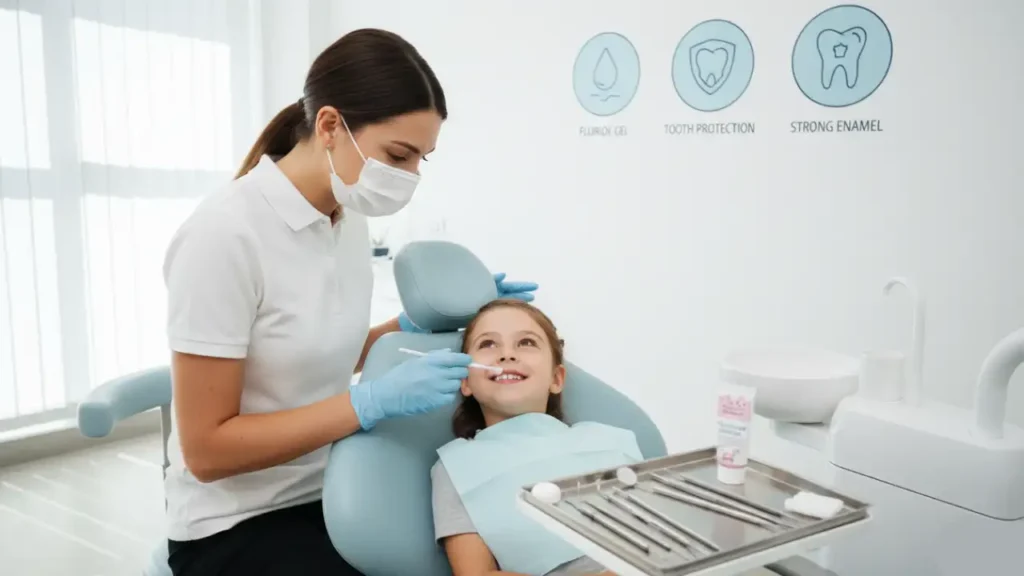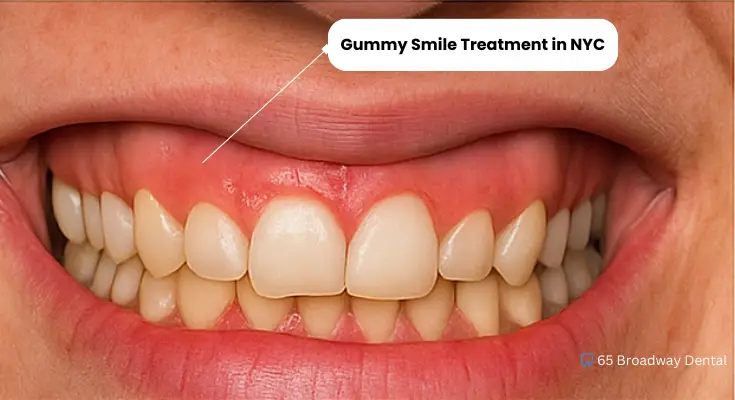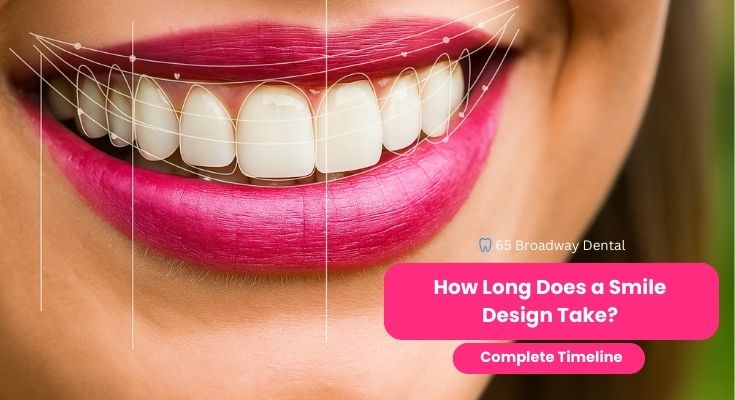Why Fluoride Treatment for Tooth Decay Matters to You
Have you ever noticed a tiny dark stain on your tooth or experienced a sting when you drank something cold? You’re not by yourself! Over 2.3 billion people worldwide suffer from tooth decay, putting many smiles at risk.
The good news? A fluoride treatment for tooth decay can help stop it before it even starts. And it’s easier than you think! You don’t need fancy tools or expensive treatments. The same fluoride treatment for teeth that your dentist gives, or the fluoride in your toothpaste, helps protect your enamel and keep your teeth healthy. just like a regular dental cleaning does for your smile.
A brief fluoride tooth cleaning with a gel, foam, or varnish may be part of your dentist’s fluoride treatment during a visit. Even though it only takes a few minutes, it can have a significant impact on cavity prevention.
Another unique kind is cavity treatment with silver diamine fluoride. This prevents tiny cavities from growing larger and occasionally even eliminates the need for a drill!
Fluoride works by making your teeth stronger and helping them repair tiny spots before they turn into full cavities. It’s safe, simple, and backed by experts like the American Dental Association (ADA), the CDC, and new 2025 research.
Ask your dentist about fluoride treatment for cavities if you want to improve the appearance of your smile; it’s one of the simplest ways to maintain the health of your teeth for the rest of your life!
Wait, How Does Fluoride Actually Fix My Teeth?
Let’s keep this simple, your teeth aren’t hard rocks. They’re made of living tissue that can get weak over time. Every time you eat sugary foods or snacks with carbs, tiny bacteria in your mouth start making acid. That’s why learning about the hidden sugar in kids’ food can help you protect your teeth and prevent decay. That acid slowly eats away at your tooth enamel, the strong, shiny outer layer that protects your teeth. When enamel wears down, that’s how a cavity begins.
Fluoride for tooth decay can help in this situation. Imagine it as a group of assistants who use stronger materials to fix and shield your teeth:
- Your saliva contains calcium and phosphate
- Fluoride pulls these minerals together
- Forms fluorapatite, stronger than enamel
- Makes teeth more resistant to acid
- Bacteria produce acid from sugar
- Fluoride lowers their activity
- Slows down acid production
- Prevents decay from spreading
The outcome? The early stages of tooth decay, such as tiny white spots or soft areas, can actually be fixed with fluoride before they develop into actual holes.
Regular fluoride treatment of teeth can reduce the incidence of new cavities by up to 60% in children and 25–40% in adults, according to studies.
Don’t drill. No filler. Simply stronger, more intelligent teeth that remain healthy with a little fluoride assistance!
Your Daily Fluoride Treatment for Teeth Routine (That Actually Works)
You don’t have to live at the dentist’s office to keep your teeth strong and cavity-free. Your teeth’s fluoride treatment begins at home, and it’s very simple to follow!
This is your easy daily schedule for dental health:
Toothpaste:
Use a toothpaste that has 1,000-1,500 ppm fluoride.
- For kids under 3: just a tiny smear, about the size of a grain of rice.
- For kids 3-6: a pea-sized amount is perfect.
Tap Water:
If your city water has about 0.7 ppm fluoride, you’re already getting a gentle, daily dose that helps protect your teeth. To boost your routine, follow a solid morning routine for healthy gums and proper brushing techniques every day. Not sure if your water has fluoride? You can check it using the CDC’s “My Water’s Fluoride” tool; it’s quick, free, and takes only a few seconds!
Mouthwash (Optional):
For added protection, use a mouthwash containing 0.05% fluoride once daily if you have braces, dry mouth, or a soda addiction.
By following your daily routine, you can reduce cavities by approximately 25% with this easy fluoride cleaning habit.
When to Call in the Pros: Fluoride Treatment Dentist Edition
In addition to cleaning your teeth, your dentist can professionally apply fluoride to your teeth to give your smile a boost. One of the best ways to maintain strong enamel and prevent cavities is to see a dentist who uses fluoride treatments.

What actually occurs during a fluoride treatment at the dentist is as follows:
Fluoride Varnish
A flavor-infused, sticky gel is applied by your dentist and solidifies on your teeth. For four to six hours, it releases fluoride gradually, providing additional protection for your enamel. Kids typically adore it because it tastes like bubblegum or banana!
As soon as the child’s first tooth erupts, at six months old, the American Dental Association advises beginning this.
Fluoride Gel or Foam
For this kind, you bite down gently for one to four minutes after your dentist fills a tray with fluoride gel or foam. With about 12,300 parts per million of fluoride, this version is far more potent than toothpaste and is ideal for those who frequently get cavities.
5. LocationHow Often Should You Go?
- Low risk: Once a year (during your regular cleaning)
- High risk: Every 3–6 months (if you have braces, gum problems, or frequent decay)
These treatments are quick, painless, and often covered by insurance. Regular visits can also help you spot gum disease warning signs and treatment options early.
Therefore, visiting your dentist for a fluoride treatment could be the simplest, quickest, and least stressful way to protect your smile if you’re sick of having to deal with unexpected fillings!
Early Decay? Fluoride Treatment for Cavity to the Rescue
During an X-ray, did you notice a dark shadow or a chalky white spot on your tooth? Do not be concerned! Fluoride treatments for cavity issues can frequently prevent decay before it becomes a real hole if they are detected early.
Here’s how it works:
High-Strength Prescription Paste (5,000 ppm)
You may receive a special fluoride toothpaste to use at home from your dentist. It functions similarly to ordinary toothpaste, but it is far more potent. This additional fluoride aids in repairing damaged enamel and halting the progression of decay.
In-Office Fluoride Varnish
Your dentist can immediately apply a potent fluoride varnish if they see an early cavity developing. It gives your tooth a concentrated dose of protection exactly where it’s needed most.
According to studies, regular fluoride treatment for teeth can prevent or even reverse about 70% of early cavities. Not a drill. No numbing. No frightful “open wide” moments.
A straightforward, scientifically supported method for promoting self-healing teeth.
The Cool Kid on the Block: Silver Diamine Fluoride Cavity Treatment
This one is quite remarkable. Like a superhero for teeth, silver diamine fluoride cavity treatment (SDF) can save areas that conventional fluoride cannot completely restore.
Here’s how it works:
- It’s a clear liquid that your dentist brushes right onto the cavity.
- The silver kills the harmful bacteria almost instantly.
- The fluoride hardens the tooth from the inside out.
The outcome? Without a drill, a shot, or any stress, about 80% of cavities stop growing in six months.
- Kids with baby teeth especially those who’ve had cavities before. These teeth will fall out anyway, so stopping decay now prevents pain and infection.
- Seniors with root cavities a common problem after 60 when gums recede and roots get exposed. Decay spreads faster in roots, but SDF can stop it without drilling.
- Anyone nervous at the dentist no shots, no noise, no drills. Just a quick brush-on treatment.
- People with cavities in hard-to-reach spots like between teeth or near the gum line where tools can’t easily fit.
The only drawback is that the treated area becomes black, resembling a tiny tattoo. Don’t worry, though; that dark spot indicates that the decay is dormant and cannot spread or hurt.
The way dentists treat cavities in 2025 is rapidly changing thanks to this gentle, no-drill silver treatment that is safe, quick, and incredibly effective!
Is It Safe? (Yes, But Let’s Talk Fluorosis)
You might be wondering, “Wait… isn’t fluoride dangerous?” Let’s clear that up.
Dental fluorosis is when kids under 6 get too much fluoride while their teeth are still forming. It can cause faint white streaks or spots on the teeth, but here’s the good news: it’s only cosmetic. That means it doesn’t hurt, weaken teeth, or cause any health problems. In fact, good oral care habits even support your whole body; see how dental health affects overall health. In fact, about 41% of U.S. teens have mild fluorosis, and most barely notice it.
- Kids under 3: Use only a rice-grain–sized smear of toothpaste.
- Kids 3–6: Use a pea-sized amount of toothpaste.
- Teach kids to spit, not swallow — no rinsing right after brushing.
- Skip fluoride supplements unless your dentist says so or your water has no fluoride.
Relax if you’re concerned about fluoride toxicity! To reach dangerous levels, you would need to consume roughly 93 gallons of fluoridated water all at once. It’s simply not feasible.
One of the biggest achievements in public health over the past century is the use of fluoride to treat tooth decay, which is totally safe when done correctly.
Conclusion
Fluoride may not seem like much, but it has a big impact. It quietly keeps your teeth strong, smooth, and cavity-free, whether you use it every day or get a quick fluoride treatment at the dentist.
A silver diamine fluoride cavity treatment for early decay, an at-home fluoride rinse, or even a basic fluoride treatment for tooth decay all aid in your teeth’s self-healing process before major issues arise.
The finest aspect? It is inexpensive, safe, and supported by decades of research from reputable medical organizations like the CDC and ADA.
So, brush smart, drink fluoridated water, and visit your dentist regularly. If you’re ready to improve your smile, explore teeth whitening in NYC or a full smile makeover to keep your teeth bright and healthy. Your smile deserves that extra layer of protection, because strong, healthy teeth never go out of style.
FAQs
1. What is a fluoride treatment for teeth?
Fluoride treatment is when your dentist applies a special gel, foam, or varnish that strengthens your tooth enamel and helps stop cavities before they form.
2. How does fluoride help prevent tooth decay?
Fluoride repairs weak enamel by forming a stronger layer called fluorapatite and also slows down bacteria that cause cavities.
3. Is fluoride treatment safe for kids and adults?
Yes! Fluoride is completely safe when used correctly. Dentists even recommend it for children as young as six months old to protect baby teeth.
4. How often should I get a fluoride treatment?
If you have low cavity risk, once a year is enough. If you get cavities often, every 3–6 months is best.
5. Can fluoride fix small cavities?
Yes, in the early stages! Fluoride can stop and even reverse tiny spots before they turn into real cavities, no drilling needed.

Dr. Alexander Heifitz (Author)
Dr. Alexander Heifitz is the founder of 65 Broadway Dental in NYC, where he combines advanced dental expertise with a patient-first approach. He specializes in cosmetic and restorative treatments such as dental implants, veneers, Invisalign, and smile makeovers, helping New Yorkers achieve both oral health and confidence.
Booking An Appointment
Looking for a reliable dentist in Downtown NYC? Whether you need a routine cleaning, urgent care, or a full smile transformation — we’ve got you covered. We accept most PPO insurance plans and offer flexible scheduling.
+1 (212) 430-3888
Call for appointment
Walk-ins Welcome / Same-Day Appointments Available

Related Blogs

Gummy Smile Treatment in NYC: Options That Work
Discover effective gummy smile treatments in NYC. Learn about options like Botox, veneers, and surgery to enhance your smile and boost confidence.
Read More
How Long Does a Smile Design Take?
A smile design typically takes a few weeks to months, depending on the treatment plan, procedures, and healing time needed for your perfect smile.
Read More